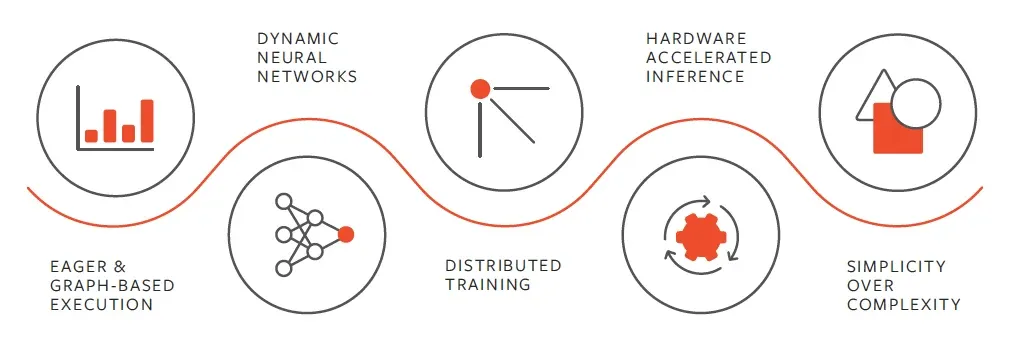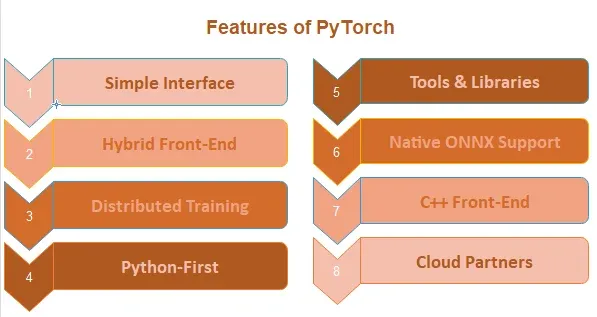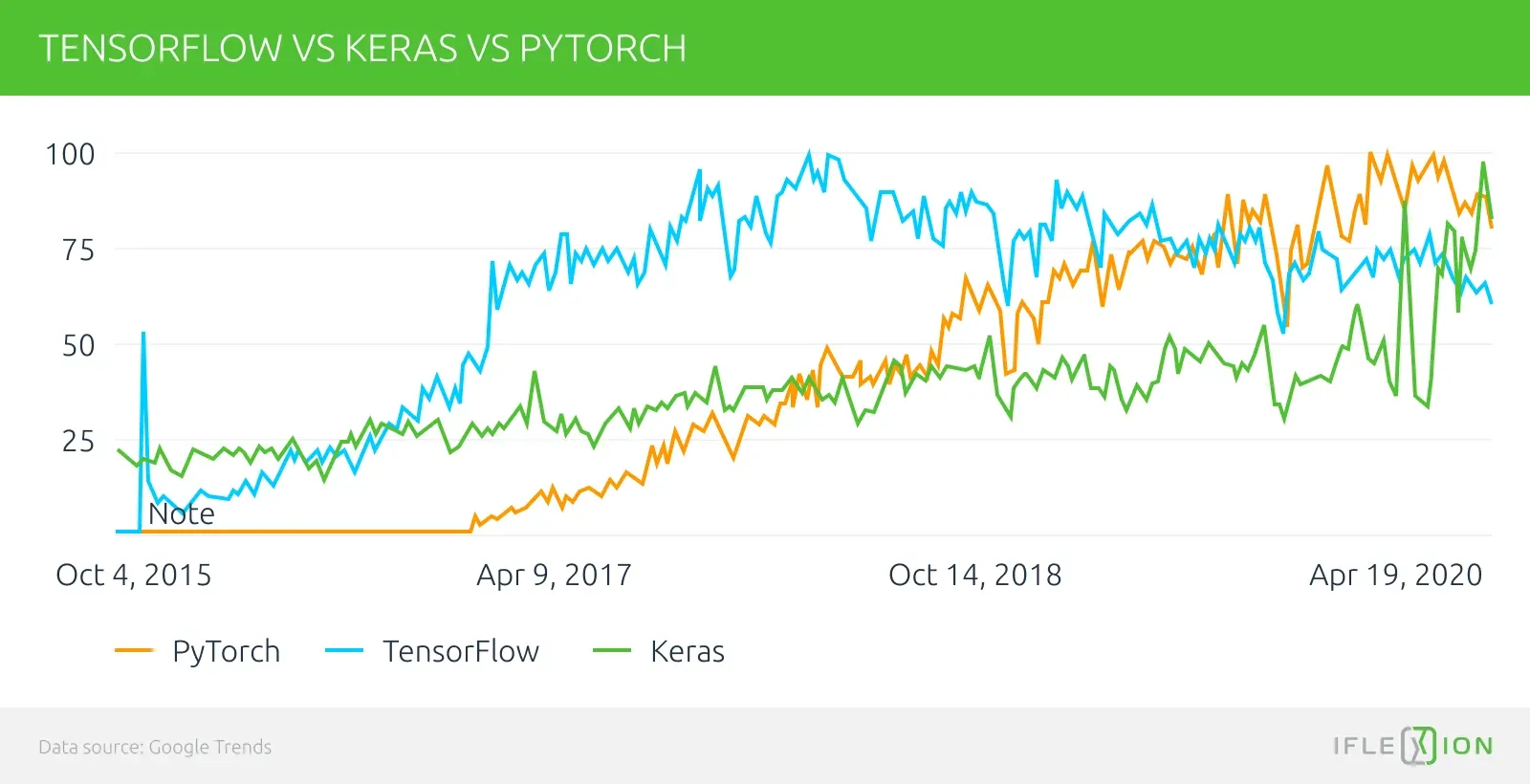Introduction
Did you know that the choice of a deep learning framework can significantly impact the success of your AI and machine learning projects?
With a wide array of frameworks available, selecting the right one often becomes a challenge.
In this blog, we compare PyTorch and Keras, two leading frameworks that have created quite a buzz in the deep learning community.
As you delve into the world of AI, it's crucial to understand the pros and cons of each framework and determine which best fits your needs.
We'll explore every aspect of these popular frameworks, from their ease of use and community support to their flexibility and performance.
While Keras is known for its user-friendly features, PyTorch has garnered appreciation for its dynamic computational graph and vast ecosystem.
By the end of this blog, you'll have a clearer understanding of the strengths and weaknesses of PyTorch and Keras, and be armed with the knowledge to make an informed decision for your next deep learning venture.
What is PyTorch?
PyTorch is an open-source deep learning framework developed by Facebook's AI Research lab (FAIR) that provides maximum flexibility and speed.
It is known for its Pythonic nature and ease of use.

Features of PyTorch
PyTorch comes loaded with features that make it flexible and easy-to-use. Some of its distinctive features include dynamic computation graphs, native support for Python, support for CUDA, and strong support for data loading.
Installing PyTorch and Getting Started
You can easily install PyTorch with pip or Anaconda via the command-line interface. Just type pip install torch or conda install pytorch depending on your Python setup.
Once PyTorch is installed, you can follow PyTorch tutorials on its GitHub page to get started with developing machine learning models.
Community and Support for PyTorch
The community is where PyTorch truly shines. Its large and active community offers excellent support to both beginners and advanced users.
With numerous PyTorch tutorials and guides available, users find it easy to learn and utilize its full potential.
Real-world Use Cases of PyTorch
PyTorch is widely used in academia and industries for tasks including computer vision, natural language processing, and artificial intelligence.
Companies like Facebook, Uber, and Twitter use PyTorch for their machine learning needs.
What is Keras?
Keras is an open-source deep learning library written in Python. It is known for being minimalist, heavily optimized, and remarkably easy-to-use. It serves as an interface for the TensorFlow library.

Features of Keras
Keras is designed with user-friendliness and modularity in mind.
It offers consistent & simple APIs, minimizes the number of user actions required for common use cases, and provides clear & actionable error messages.
Installing Keras and Getting Started
The easiest way to install Keras is to install it with TensorFlow, as it comes with a set of TensorFlow-specific functionalities.
Once Keras is installed, you can kickstart your journey with Keras's comprehensive guides available on its official page.
Community and Support for Keras
Keras, like PyTorch, has a vibrant community that offers robust support to its users.
From beginner-friendly guides to expert-level discussions, the Keras online community is a boon for everyone who wants to dig deep into deep learning.
Real-world Use Cases of Keras
Keras is extensively utilized in start-ups as well as in research groups of companies like Google thanks to its simplicity and ability to scale. It extensively aids in text and image applications.
What are different PyTorch Features?
In this section, we'll explore the standout features of PyTorch, from its dynamic computation graph to the robust ecosystem and cloud support.
Dynamic Computation Graphs in PyTorch
Unlike most deep learning frameworks, PyTorch allows you to create and adjust computational graphs on-the-fly - a feature known as a dynamic computation graph.
It means you're not confined to a predefined architecture and can adjust your model's structure as you go. It offers great flexibility, especially for complicated models and experimenting with unconventional ones.
PyTorch's Integration with the Python Ecosystem
There's no overstating how well PyTorch integrates with the Python data science stack. You can use PyTorch seamlessly with popular Python libraries like NumPy, Scikit-learn, and more.
This integration simplifies data preprocessing, analysis, and visualizing training process, keeping all your work in a coherent, easy-to-follow Pythonic flow.
Extensibility and Modularity in PyTorch
Modules - building blocks in PyTorch - can be combined to build complex deep learning models. The framework allows you to design tailored layers, loss functions, and other components for your specific needs.
Its extensible design encourages a clean, modular programming style - a boon for readability, and collaborative projects.

Distributed Training with PyTorch
For large-scale deep learning, PyTorch offers native support for distributed computation.
torch.nn.DataParallel and torch.nn.DistributedDataParallel facilitate parallel processing over multiple GPUs.
PyTorch's distributed package aids working over several machines without a hitch, making training large models or using huge datasets more manageable.
Robust Ecosystem and Cloud Support in PyTorch
PyTorch's ecosystem is vast, filled with handy libraries (torchvision,torchaudio,torchtext) to aid pre-processing and model building. Also,partnerships with cloud providers ensure seamless transition of PyTorch models into production.
Amazon's 'AWS Deep Learning AMI' and Google's 'Cloud Platform Deep Learning VM Image' come pre-configured with PyTorch, smoothing the path to deploying your models at scale.
What are different Keras Features?
Let's delve into Keras's notable features, from its user-friendly design to robust TensorFlow integration.
Sequential and Functional API in Keras
Keras offers two ways to build models: the Sequential API - a stack of layers where data flows linearly, and the Functional API - allowing complex, multi-output networks.
Both maintain simplicity in their syntax. Even with minimal Python knowledge, building a neural network using Sequential or Model classes in Keras is quite straightforward.
User-friendliness of Keras
Keras stands out as an accessible entry point to deep learning. With abstractions for many complex details, and pre-defined layer types and loss functions, beginners can rapidly prototype models.
The emphasis on user experience, combined with excellent documentation, makes your Keras journey smoother and more pleasant.
Modularity and Composability in Keras
In Keras, models are assembled using building blocks, encouraging modularity. A model can be understood as a sequence or a graph of standalone, fully-configurable modules.
These modules can be combined with few restrictions, supporting a wide variety of designs for neural networks.

Integrated Support for Convolutional and Recurrent Networks in Keras
Keras includes extensive built-in support for deep learning staples: Convolutional Neural Networks (CNNs) and Recurrent Neural Networks (RNNs). Keras's Conv2D, MaxPooling2D and LSTM layers - along with many others - provide straightforward ways to implement these architectures to solve complex tasks like image classification and sequence prediction.
Robust Integration with TensorFlow
Keras serves as TensorFlow's official application modeling high-level API, allowing users to leverage TensorFlow's power with Keras's simplicity.
Keras models can be converted seamlessly to TensorFlow, allowing direct access to lower-level TF functions if needed, and doesn't skip out on any TensorFlow-specific features because of strong integration.
Choosing the Right Framework: Factors to Consider
Choosing between PyTorch and Keras doesn't have to be daunting. We'll guide you through key factors, from your project requirements to the importance of experimentation.
Assessing Your Project Requirements
Your project needs should be paramount. Assess whether you need flexibility for more complex models (PyTorch's forte) or user-friendly interfaces for rapid prototyping (Keras shines here).
Fast execution, memory footprint, GPU utilization - all must align with your project's objectives.
Choice Based on Performance
In terms of performance, both serve well, though PyTorch's dynamic computational graphs allow efficient memory usage during computation.
Assess your needs for training speed, memory usage, and direct hardware control to guide your selection here.
Ease of Learning and Community Support
Keras's simplicity is great for beginners; PyTorch's Pythonic design appeals to those with scripting experience. Consider your comfort level with Python and neural networks.
Both frameworks have vibrant communities providing support, so peruse their documentation, forums, and GitHub repos to gauge which you find more helpful.
Evaluating the Ecosystem and Integrations
Examine the libraries and tools surrounding each framework. PyTorch's integration with Python libraries and extensible design can streamline your workflow, while Keras's integration with TensorFlow leverages TensorFlow's rich ecology and performance.
The Importance of Experimenting
Finally, experiment. Nothing substitutes hands-on experience in understanding these deep learning frameworks. Try installing Keras or PyTorch (you can easily pip install PyTorch or Keras), follow a tutorial or two, and get a feel for each environment before settling down.
Remember, it's absolutely fine to prefer one over the other. What matters is how effectively you utilize the chosen tool to implement your learning algorithms and achieve your goals.
Comparison: PyTorch vs Keras
In this section, we will compare PyTorch and Keras, focusing on five critical aspects. These include ease of use, performance, flexibility, community support, and adoption in industry and academia.
We believe that this comprehensive comparison will empower you to make an informed decision about which deep learning framework is the right one for your needs.

Comparison Based on Ease of Use
Keras is often touted as the go-to choice for beginners, thanks to its user-friendly API. It has less boilerplate code, providing a clear and simplified coding experience. On the other hand, PyTorch also offers an easy-to-understand syntax and its comprehensive tutorials provide a smooth learning curve for beginners.
While Keras provides a higher level of abstraction that makes coding complex architectures feel more straightforward, PyTorch allows for more manipulations. For complex and customized models, PyTorch might be easier because of its lower level of abstraction.
Speed and Performance Comparison
When it comes to speed, PyTorch has gained a significant advantage due to its native support for dynamic computational graphs. It allows for on-the-fly changes during execution, offering efficient use of memory and processing power. Keras, being a higher-level API that sits on top of TensorFlow or Theano, may have slight overheads that could impact performance.
Both Keras and PyTorch support GPU acceleration, enabling faster computation times. While Keras relies on TensorFlow for handling GPU memory, PyTorch uses CUDA directly, providing fine-tuned control over memory management.
Comparing Flexibility and Modularity
PyTorch offers flexibility in designing dynamic models, making it suitable for complex architectures. In contrast, Keras, with its Sequential and Functional APIs, offers easy-to-use tools for building more straightforward and static models.
The dynamic computation graph in PyTorch is an asset for testing and debugging, allowing step-by-step network debugging similar to traditional Python programming. Keras, on the other hand, requires the model to be compiled before running, making debugging a bit more challenging.
Community Support and Resources
Both frameworks have extensive documentation and learning resources. Keras is well-known for its clear and detailed documentation, while PyTorch provides extensive tutorials and examples covering a wide range of topics.
The open-source communities of both frameworks are large and active. They provide regular updates, improvements and quickly solve issues raised by users. Community contributions to these frameworks have played a key role in their rapid growth.
Industry and Academia Usage: PyTorch vs. Keras
While both frameworks are used in academic research, PyTorch is often more popular due to its dynamic nature, enabling on-the-fly changes and complex models. Its compatibility with Python's tool suites also makes it appealing to researchers.
When it comes to industry, Keras often shines due to its simplicity and ease of use, which can speed up the development process in production environments. However, PyTorch's TorchServe — a flexible tool for deploying PyTorch models — is making waves in industry applications too.
Conclusion: PyTorch or Keras
PyTorch stands out with its dynamic computation graphs and developer-friendly interface, fostering an environment for researchers and developers favoring a 'pythonic' way.
Keras, boasting its simplicity and streamlined workflows, is the go-to for enthusiasts and professionals looking for quick implementation and a TensorFlow-backed core.
Making the Final Decision: PyTorch or Keras
The decision boils down to your project priorities, technical prerequisites, and personal inclinations.
PyTorch is enticing for dynamic environments and cutting-edge research, while Keras is ideal for straightforward designs and fast prototyping.
Emphasizing on the Importance of Experimentation and Flexibility
Experimentation is key in this constantly evolving field. Both frameworks offer the flexibility needed to innovate and should be explored to identify their fit for your unique case.
Whether PyTorch's flexibility or Keras’s user-friendliness, trying hands-on is the best strategy to understand their potential.
Future Outlook: PyTorch and Keras
The future of both frameworks looks promising, with dedicated communities continually fine-tuning these interfaces.
PyTorch is carving its niche in both research and industry, while Keras, under the TensorFlow umbrella, is expected to stay at the forefront of API simplicity and model deployment.
The journey doesn't end here. Leverage the wealth of resources available for both PyTorch and Keras. Tutorials, forums, and official documentation can significantly enhance your understanding and skills. Whether you prefer PyTorch's agility or Keras's accessibility, continuous learning will blaze your trail in the AI landscape.
Suggested Reading: Understanding the Basics of Automated Machine Learning
Frequently Asked Questions (FAQs)
How Do PyTorch and Keras Handle Debugging Differently?
While PyTorch allows for a more interactive, Pythonic debugging process with its eager execution, Keras, being a high-level API, has lesser flexibility for low-level debugging.
Which of the Two is Better for Rapid Prototyping?
Keras, being a high-level wrapper, is simpler to use and quicker for prototyping, whilst PyTorch demands a deeper understanding of the model architecture.
How Use Pre-Trained Models in Both PyTorch and Keras?
Yes, both PyTorch and Keras offer pre-trained models, such as ResNet, VGG, etc., useful as a starting point for transfer learning.
How is Performance Different Between PyTorch and Keras?
Performance depends on specific use-cases, but overall, PyTorch boasts better performance on certain tasks and has better support for distributed training.
Which Framework is Better Supported for Mobile Deployment?
PyTorch, with its TorchScript, provides better tools and support for mobile and embedded deployment compared to Keras.
How Do PyTorch and Keras Differ in Learning Curve?
Keras is known for its simplicity and user-friendliness, making it easier for beginners, while PyTorch is more flexible and extensive, possibly a steeper learning curve.
Which Community Support is Robust - PyTorch or Keras?
While both have substantial community support and resources, the PyTorch community is growing rapidly due to its extensive usage in research institutions.
Is There a Difference in the Basic Units used in PyTorch and Keras?
Yes, PyTorch uses tensors as its basic unit, whereas Keras uses layers as its fundamental unit in the computational graph.
How to Choose Between PyTorch or Keras for Research Purposes?
PyTorch is often preferred for research owing to its dynamic graph, broader support for different models, and better runtime control, aiding in faster experimentation.
How Do PyTorch and Keras Handle GPU Acceleration?
Both support GPU acceleration. However, PyTorch provides a simpler and more Pythonic interface for manual control over GPU computations.


